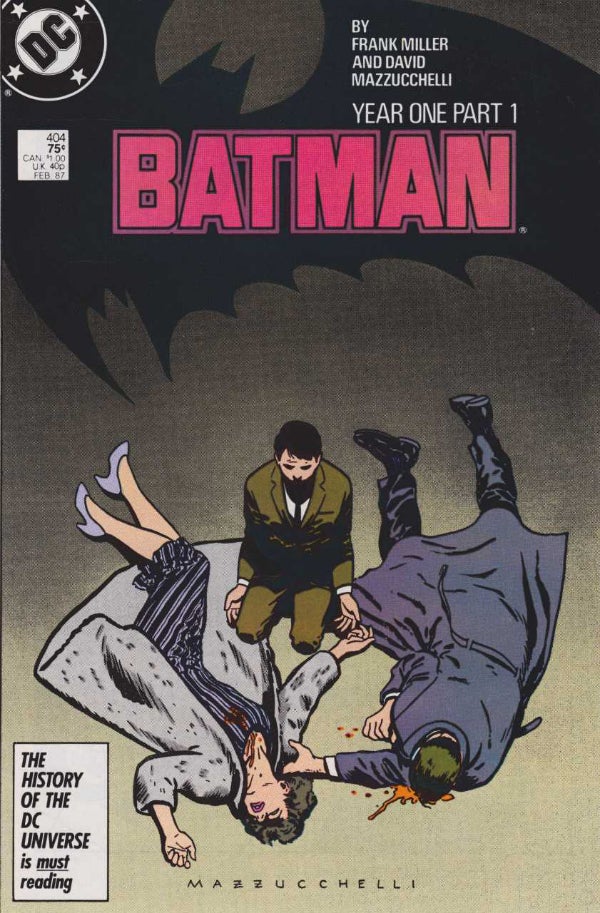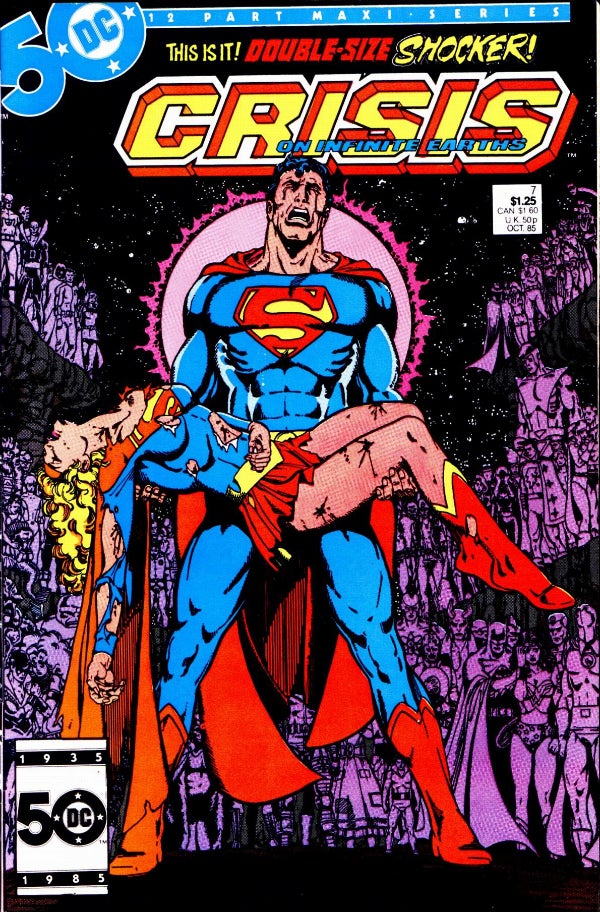5 Comic Book Retcons Worth Celebrating
Note: Contains a spoiler for Avengers & X-Men: Axis.For many comic book fans, retcons, short for [...]

Note: Contains a spoiler for Avengers & X-Men: Axis.
For many comic book fans, retcons, short for retroactive continuity, are a source of frustration and aggravation. Just imagine reading your favorite comic book character when *bam* some kind of editorial mandate comes along and now that hero is no longer married, or has a long lost brother, or was brainwashed into killing an entire universe of people.
Just recently, Marvel implemented a pretty significant retcon in its Avengers & X-Men: Axis miniseries when it was revealed that Quicksilver and Scarlet Witch's biological father was not actually the mutant Magneto. This storyline development – which interestingly enough, is taking place just months before Marvel Studios releases Avengers: Age of Ultron, which will feature both Scarlet Witch and Quicksilver but cannot legally make any mention to Magneto since all mutant properties are owned by 20th Century Fox – has led many fans to speculate what else will be changed about the Maximoff twins. Perhaps, the two will discover they are actually (Marvel Studios owned) Inhumans instead?
Anyway, we understand that retcons get a bad rap in these parts, but in an effort to be optimistic, we thought we'd point out a few instances where a retcon produced a better story/character dynamic. So before you write off the future of Scarlet Witch and Quicksilver, check out these five retcons that were actually pretty cool.

Honorable Mention: Joe Chill Did NOT Kill the Waynes
The ballad of Joe Chill, the thug who may, or may not have been directly responsible for the creation of one of the world's greatest superheroes in Batman, is a hard one to keep up with. For the uninitiated, during a Golden Age Batman story, the Caped Crusader discovers the identity of the man who killed his parents that fateful night in Crime Alley – a small-town crook named Joe Chill.
Over the years, Chill evolved from a petty thug into a major criminal force in Gotham. During the Batman: Year Two storyline, Batman is forced to team-up with Chill, before revealing his identity to him at the very end of the story. But all of this Joe Chill stuff would be (temporarily) wiped out during 1994's Zero Hour, when Batman sees an alternative timeline and determines that Chill did not actually kill his parents.
If DC had just left well enough alone, this might go down as the greatest retcon of all time. While some fans arguably were fine putting a name and a face with Batman's killers, many others thought the randomness and anonymity of Thomas and Martha Wayne's murder was a far more riveting story. To think that Bruce Wayne would torture himself over the actions of some miscellaneous crook with a gun makes his ascension into a vigilante defender of justice in Gotham City all the more compelling.
Unfortunately, the Chill retcon only lasted until Infinite Crisis, about a decade later when it is reestablished that he killed the Waynes.

5. The Hobgoblin is Roderick Kingsley
Poor Spider-Man has been at the center of a number of horrendously tone deaf retcons ("One More Day," "Sins Past," the "Clone Saga"), so it's nice to get to show the Web Slinger some love and spotlight at least one of the redos that went right for the character. Plus the story behind the Hobgoblin's secret identity is one that has taken on a life of its own and emblemized some of Marvel's editorial dysfunction during the 1980s.
Back in the early 1980s, Roger Stern, the Hobgoblin's creator, had intended to reveal his newest supervillain sensation as businessman/fashion mogul Roderick Kingsley, another character the writer had developed in the pages of Spectacular Spider-Man. However, Stern left Amazing Spider-Man before the Hobgoblin's identity was unveiled. Stern's successor, Tom DeFalco, wanted to take the character in a new direction, but he was eventually displaced from the book in an editorial spat with Jim Owsley (now Christopher Priest). That left Peter David to unmask the Hobgoblin as … Ned Leeds, the newspaper reporter for the Daily Bugle. PS, Leeds's character was actually killed off at the time he was revealed as the Hobgoblin.
The unmasking confounded fans and the Hobgoblin was used sparingly for the decade to follow. However, in the late 90s, Stern was brought back into the fold to script Hobgoblin Lives, a three-part miniseries that revealed the villain to be Kingsley, setting right what had been so so wrong years earlier.

4. The Many Faces of Captain America
One of the comic book industry's most iconic superheroes, the original Captain America, Steve Rogers, was originally conceived by Joe Simon and Jack Kirby as a piece of anti-Nazi World War II propaganda, famously punching Adolf Hitler in the face on the cover of his very first appearance, Captain America Comics #1. Cap, and his teenage sidekick Bucky Barnes (more on him shortly), continued to fight the Nazi Party throughout the early 1940s. When World War II ended, the characters supported America in its fight against the "red menace" Communism throughout the 1950s.
Fast Forward to the Silver Age and the "Marvel Age of Comics" and one of Stan Lee/Kirby's big ideas was to revive Captain America as a member of its new Avengers superteam. The duo retconned Cap's backstory that he had been presumably killed in a place crash in 1945 but was instead frozen in the water below. He was thawed out by the Avengers and became Captain America, the "man out of time" for decades to follow.
During the Steve Englehart run on Captain America and Falcon in the 1970s, Marvel retconned Cap's appearances in comics during the 1950s. According to the Englehart storyline, Rogers was still presumed dead so the U.S. created a new Cap, a man named William Burnside, who became so obsessed with Captain America, he surgically altered his face to look like his idol and legally changed his name to Rogers. This psychotic Cap, of course, resurfaced and was defeated by Rogers and Falcon.

3. Crisis on the Infinite Earths
The epitome of how retroactive continuity can improve the reading experience over the long term (unless of course, the retcon itself is ultimately retconned, as is the case here), in 1984, Marv Wolfman and George Perez set out to streamline DC's incongruous continuity. Rather than having a never-ending list of parallel worlds, and thus multiple versions of the same character, the duo developed a story where all of these different Earths would be destroyed by a cosmic powerhouse known as the Anti-Monitor, uniting the (surviving) DC Universe under one world. And thus, the iconic Crisis on the Infinite Earths was born.
Crisis is hardly perfect, and in some cases created some additional confusion/inconsistencies that other creators would attempt to clean up in events such as Zero Hour, but by destroying the Multiverse and relaunching/reimagining some of DC's core characters like Superman, Batman and Wonder Woman, the miniseries established a more easier to follow comic book world for both casual and longtime readers.
Still, DC's Multiverse would not remain dead and buried. It was later resurrected in the wake of the Infinite Crisis event, and has been the focus of such current events as Grant Morrison's Multiversity and 2015's Convergence.

2. Alan Moore's Swamp Thing
In 1984, DC's Swamp Thing was a title on the verge of cancellation and Alan Moore was a little-known British writer who had not yet worked on an American mainstream comic book. The marriage of Moore and Swamp Thing yielded what is arguably one of the greatest runs in comic book history – a run that was largely predicated on a significant retcon to the Swamp Thing character.
Prior to Moore's run, Swamp Thing was Alec Holland, a man who was turned into a vegetative monster via a chemical explosion. In Swamp Thing #21, a story entitled "Anatomy Lesson" and Moore's second issue, Swamp Thing's origin story was dramatically altered. Rather than make the character a man who was transformed into a monster, the issue depicts how a chemical explosion animated vegetation into thinking it was Holland. Holland's ghost even shows up in an issue of Moore's Swamp Thing to really drive home the point that they were separate entities.
This far out and experimental approach to comic book storytelling opened a number of doors for both Moore and the title. Swamp Thing became a very character-centric series, and was also notable for its somewhat explicit content as it related to sex and drugs. And let's not forget how Moore's Swamp Thing run introduced readers to the magician, John Constantine, a character who would get his own series in short order.

1. The Winter Soldier
For years there were two certainties in comics: that Peter Parker's Uncle Ben, and Captain America's Golden Age sidekick, Bucky Barnes, would remain dead, no questions asked. Then, Ed Brubaker came around in the mid-2000s and during his storied run on Captain America (with Steve Epting) broke every rule regarding Bucky. Not only was Barnes brought back from the dead, but he returned as a metal-armed KGB assassin dubbed the "Winter Soldier."
Brubaker and Epting followed Bucky's return with the fantastic "Death of Captain America" arc, which tied-in to Civil War. After Cap is assassinated, Bucky, who is still recovering from all of the horrible things he did while under KGB control, is tapped by Tony Stark to become the new Captain America. It turned out to be such an amazing come full circle moment, that the character has been a mainstay in the Marvel Universe ever since and was the subject of Captain America: The Winter Soldier film last spring.
0comments